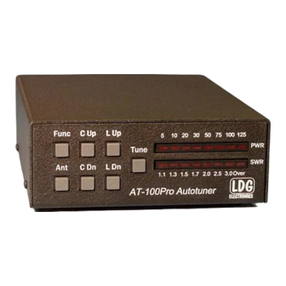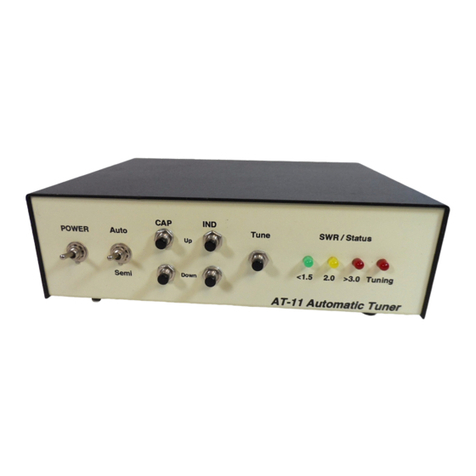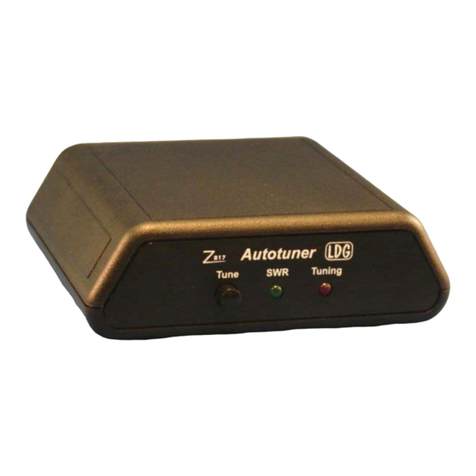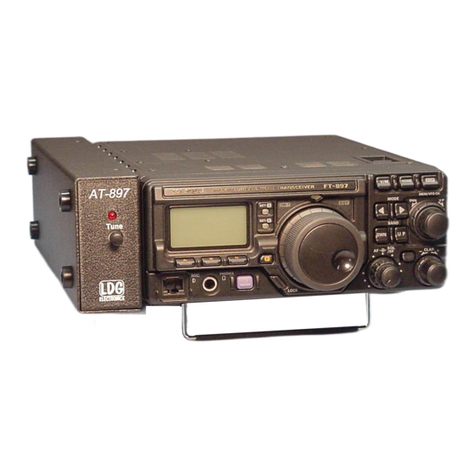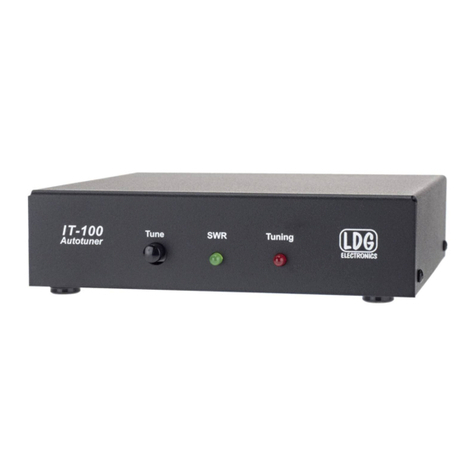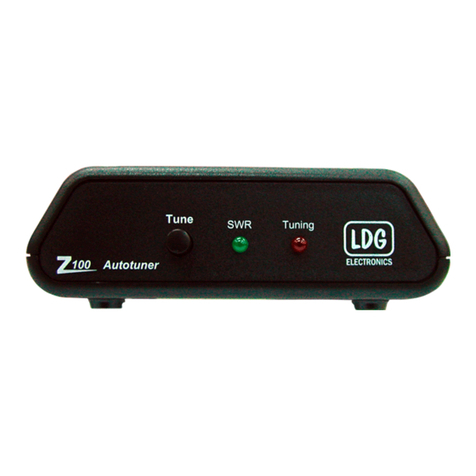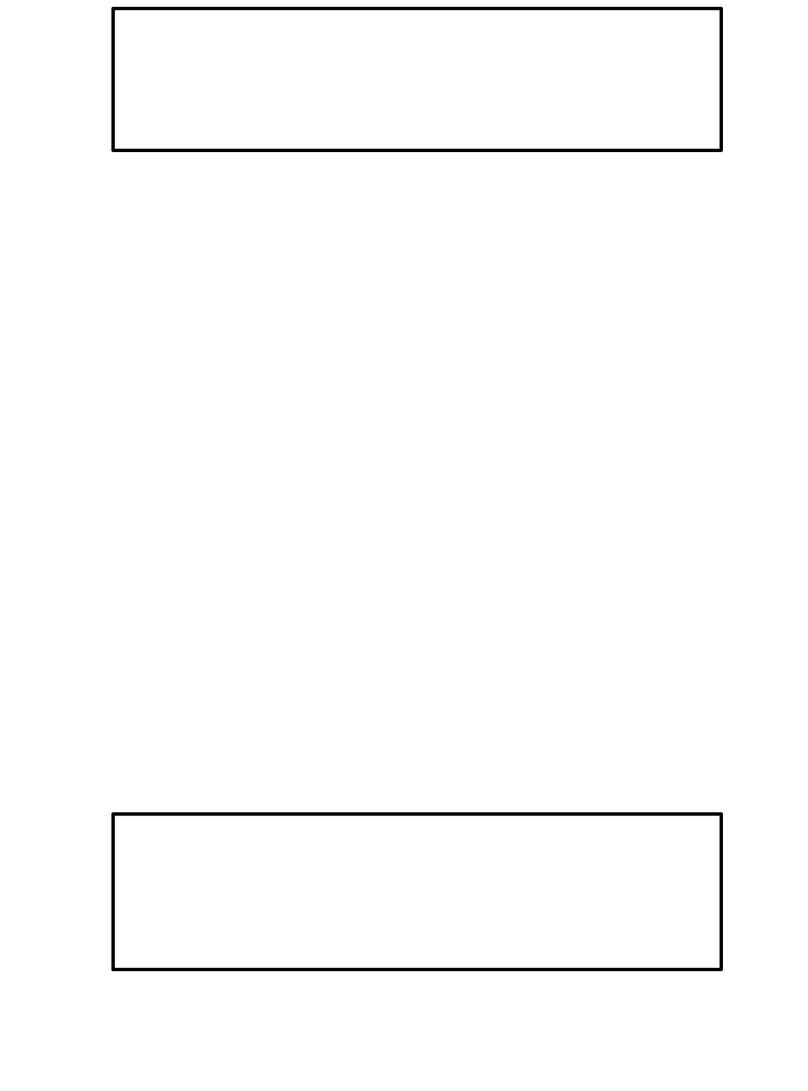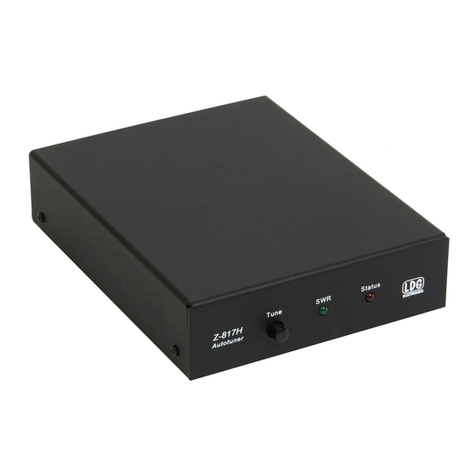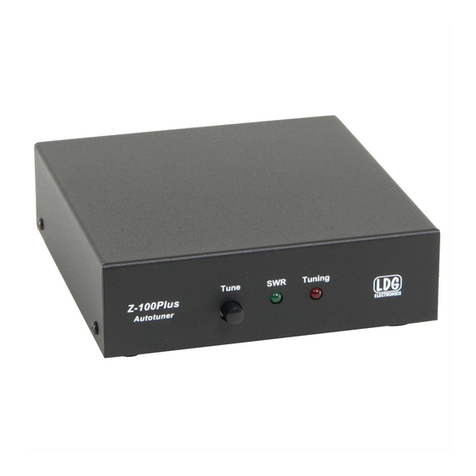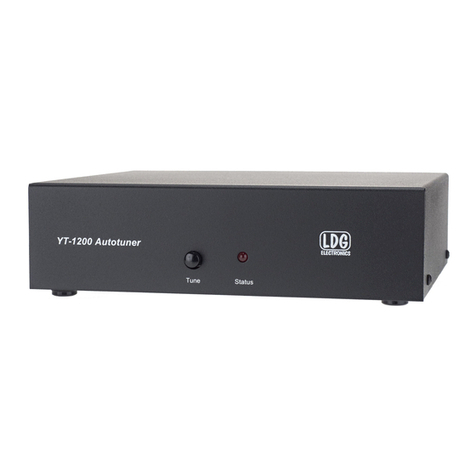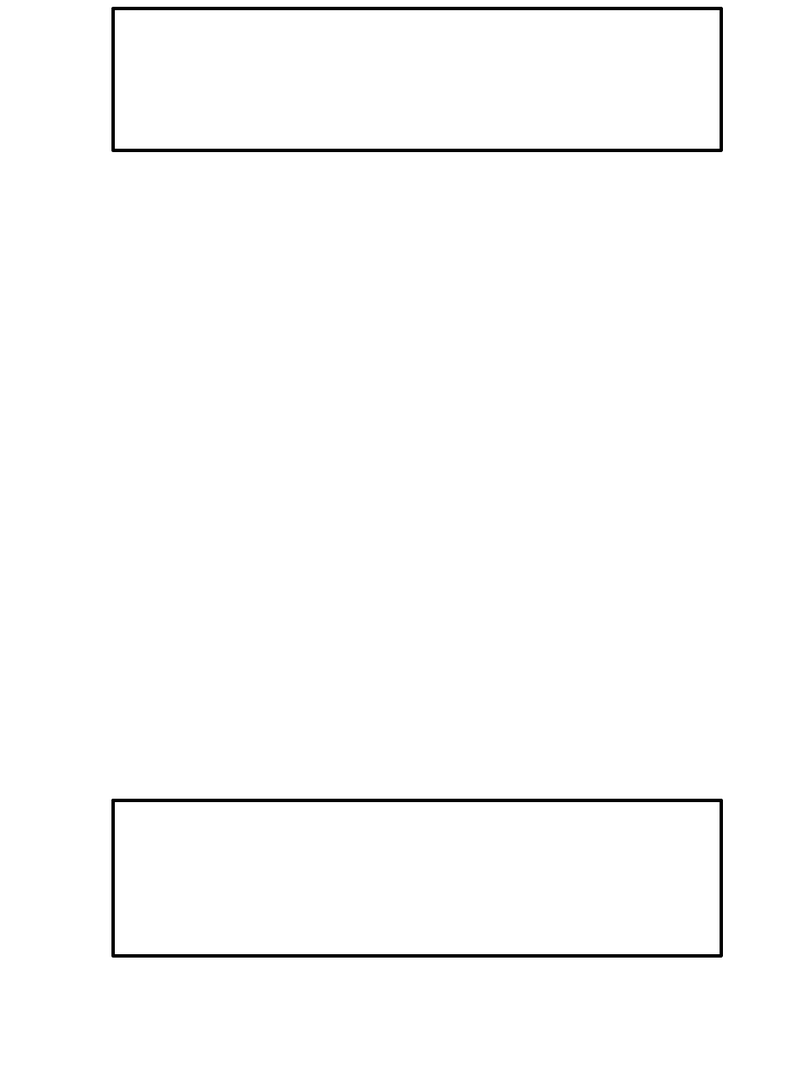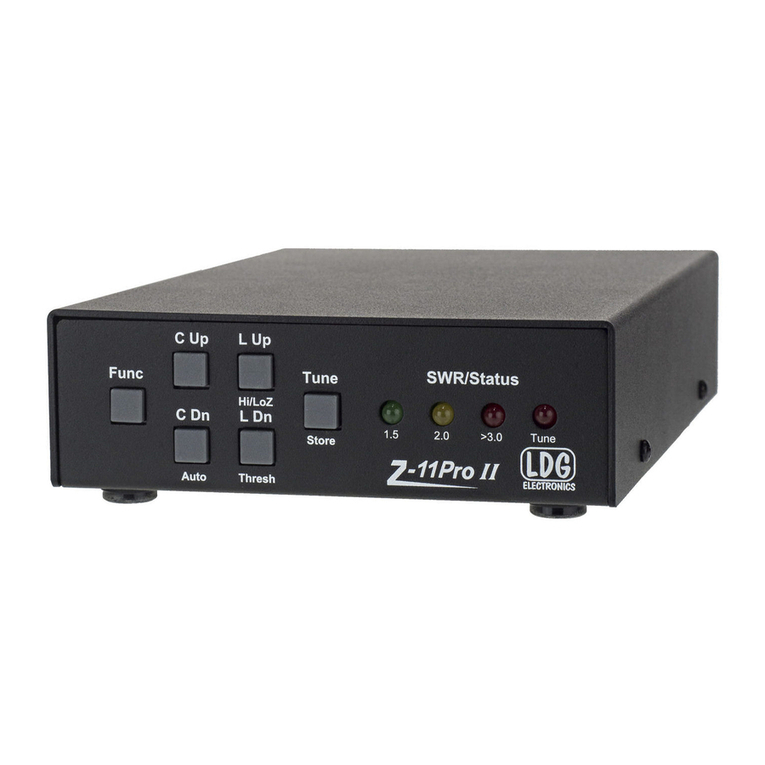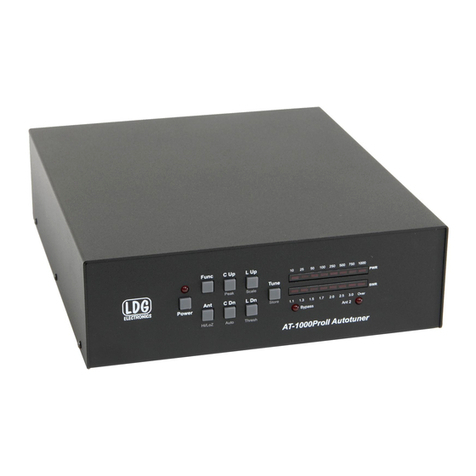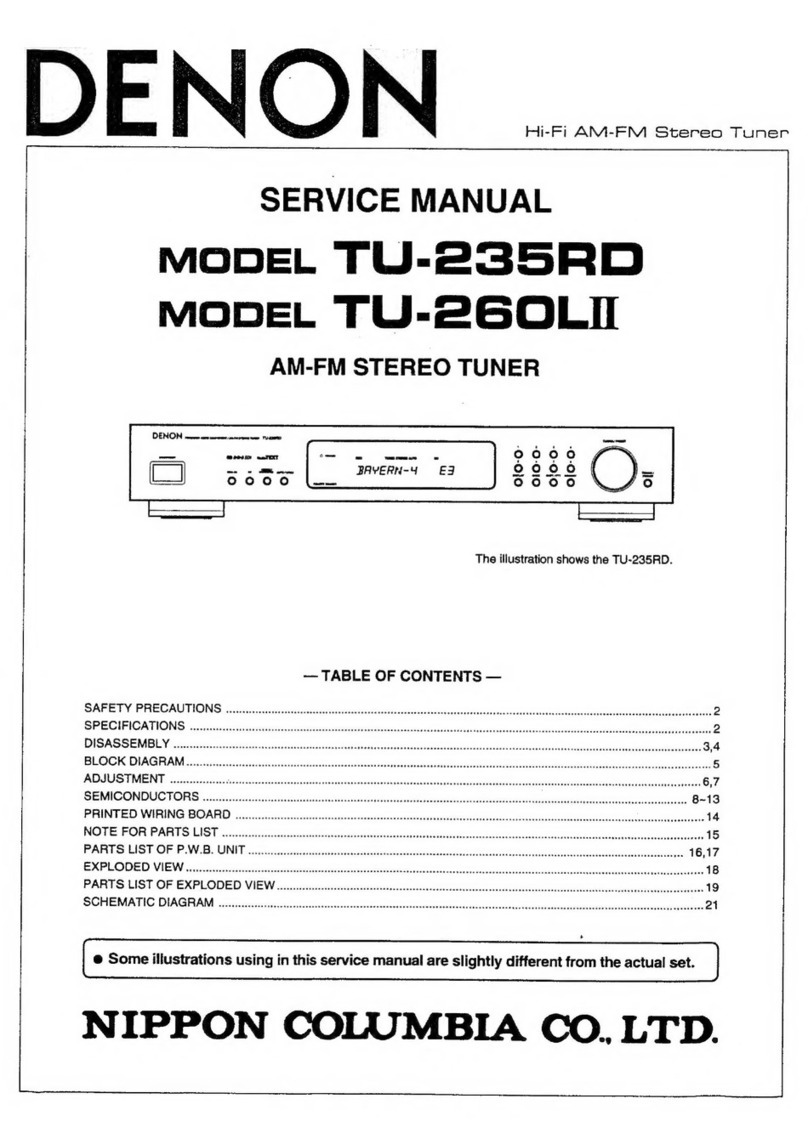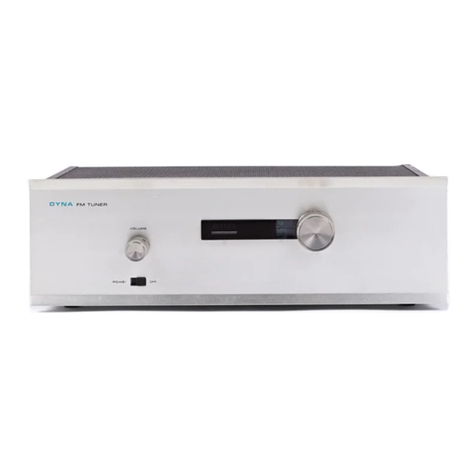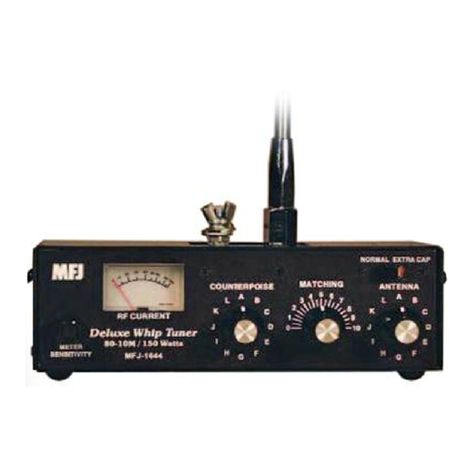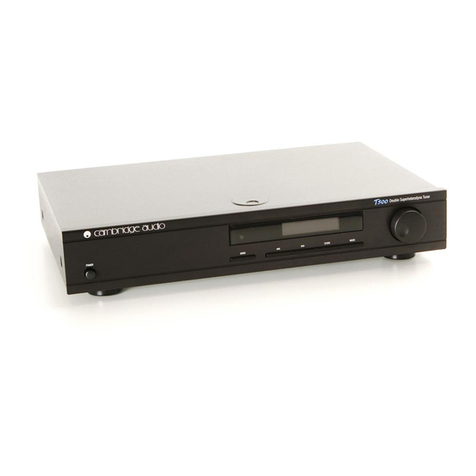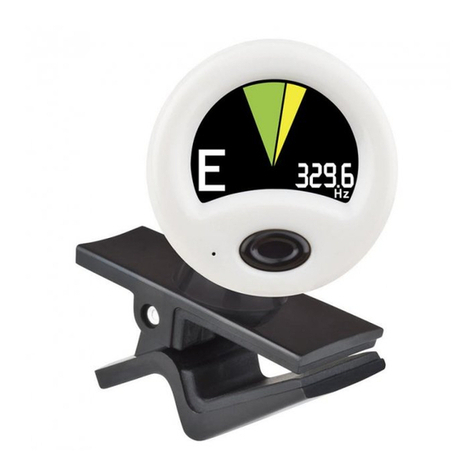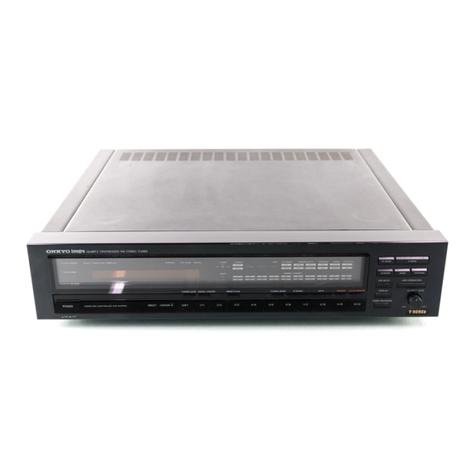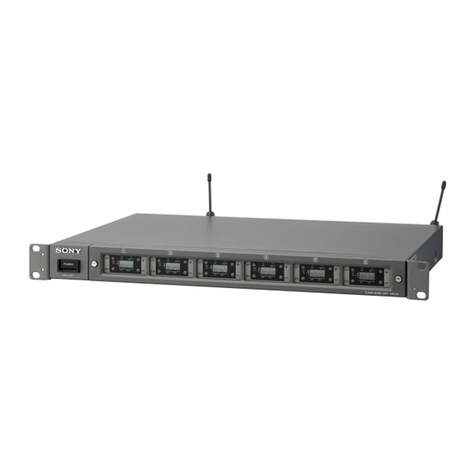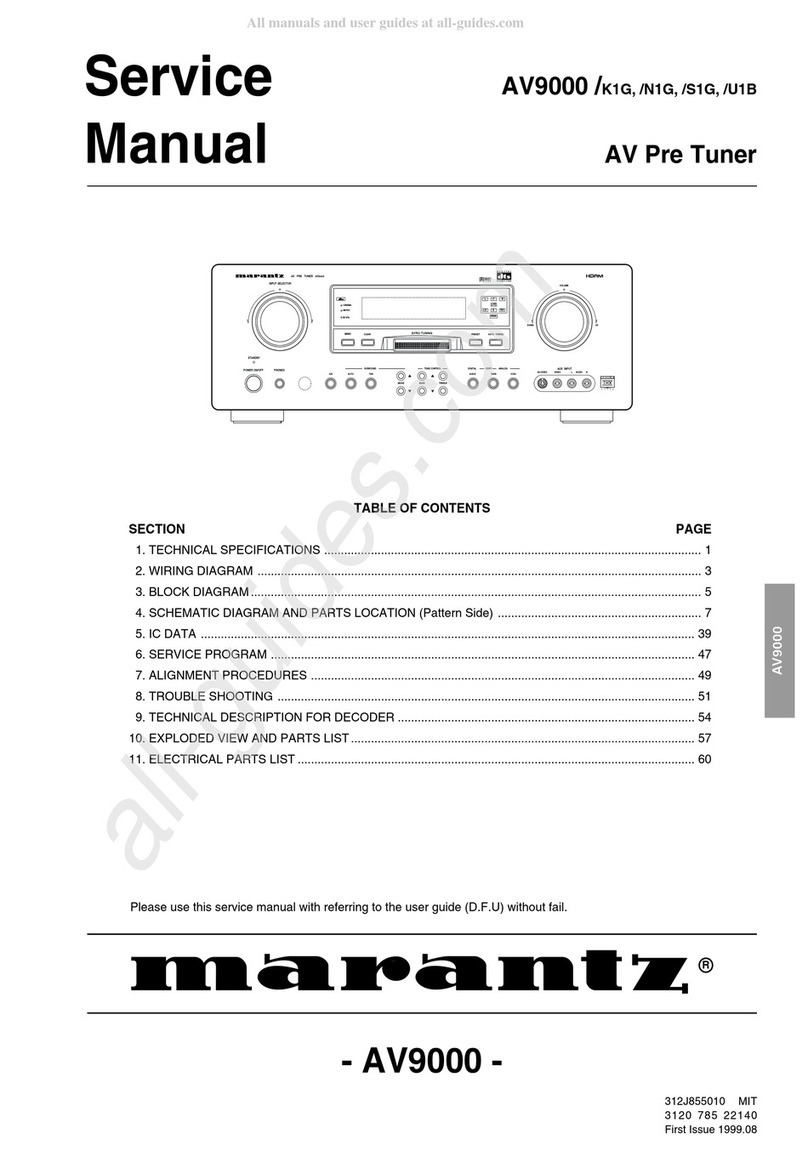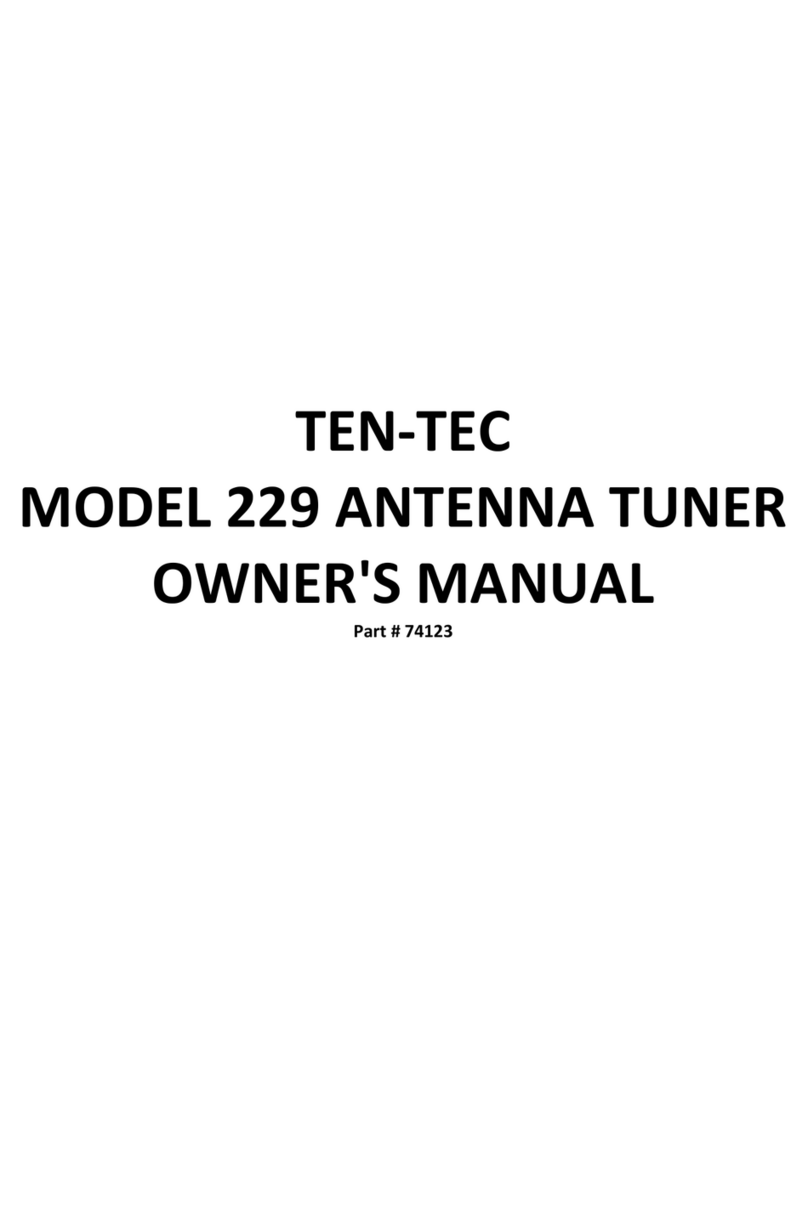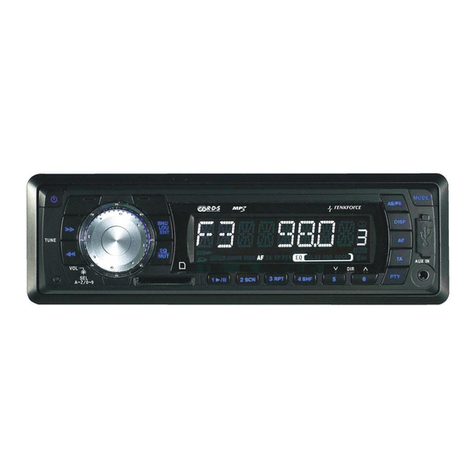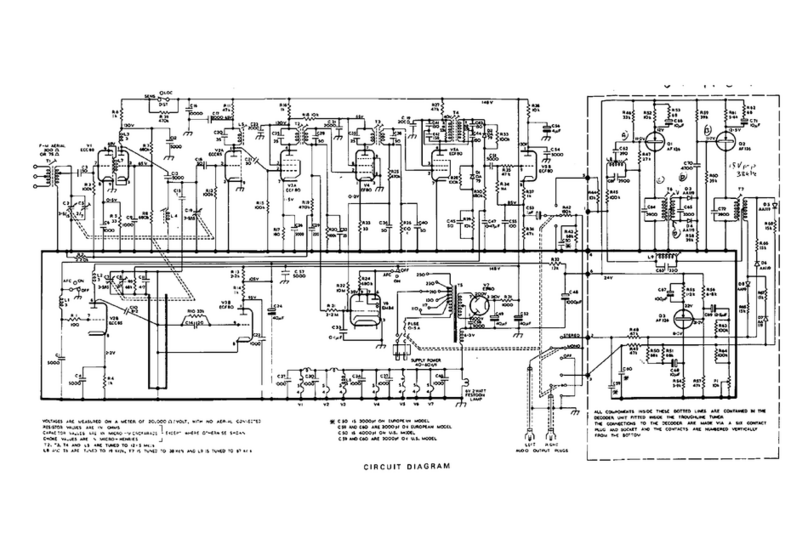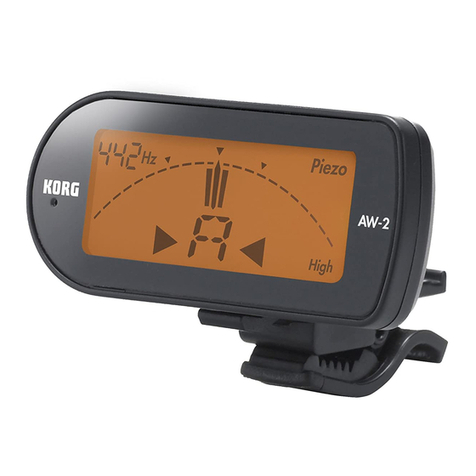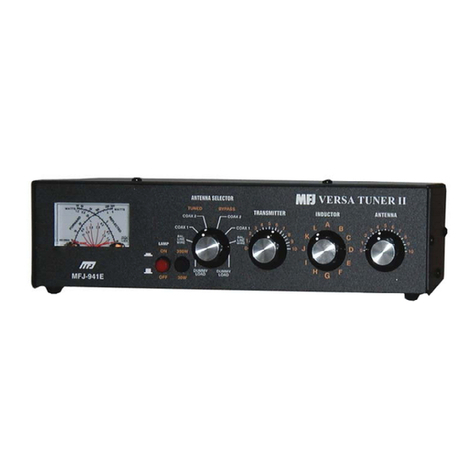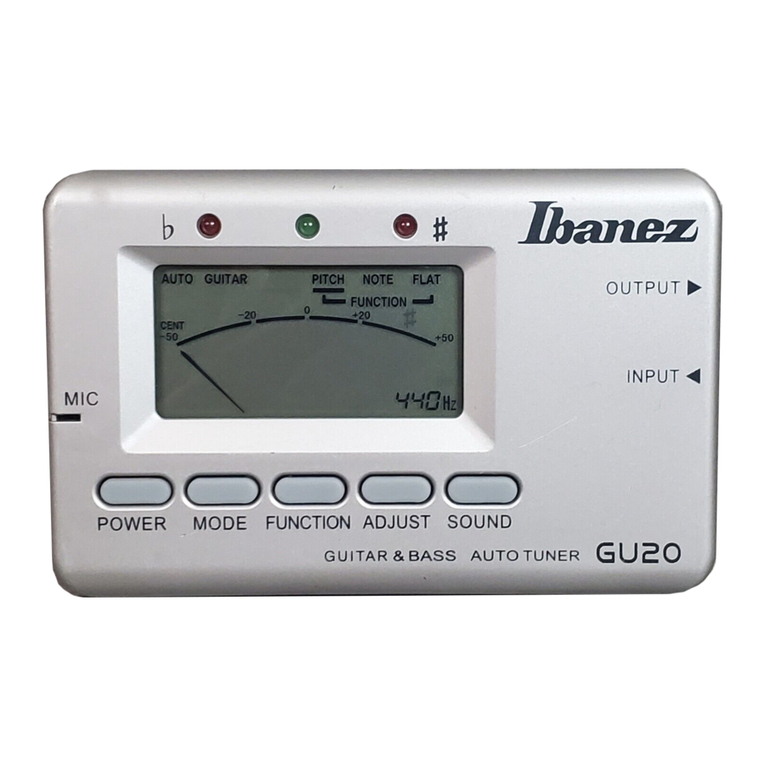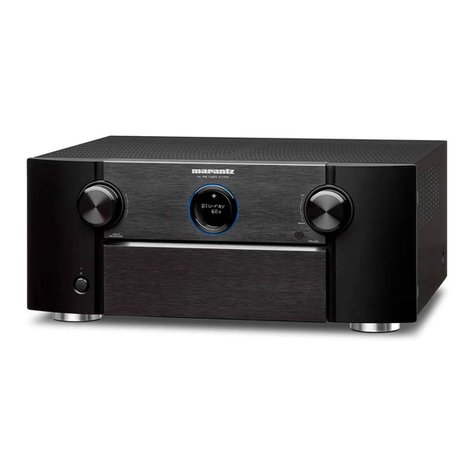LDG AT-200PROII User manual

AT-200PROII OPERATIONS MANUAL MANUAL REV B
PAGE 1
LDG AT-200ProII
200W Automatic
Antenna Tuner
LDG Electronics
1445 Parran Road
St. Leonard MD 20685-2903 USA
Phone: 410-586-2177
Fax: 410-586-8475
ldg@ldgelectronics.com
www.ldgelectronics.com

PAGE 2
Table Of Contents
Introduction 3
Jumpstart, or “Real hams don’t read manuals!” 3
Specifications 4
An Important Word About Power Levels 4
Important Safety Warning 4
Getting to know your AT-200ProII 5
Front Panel: 5
Back Panel: 6
Installation 7
Basic Operation 10
Using the Front Panel Buttons 10
User Configuration Options 10
Transmitting and Receiving 13
Bypass LED 13
Tuning 14
Basic Tuning Operation 14
Manual Memory Tune 14
Manual Full Tune 15
Bypass 15
Error Indication 16
Advanced Operation 18
Manual Inductor/Capacitor Adjustments 18
High/Low Z Relay Adjustment 18
Manual Memory Store 18
Status Check 19
Application Notes 20
Mobile Operation 20
Internally Generated RF Noise 20
MARS/CAP Coverage 20
Application Hint for Tuning with the Kenwood TS-480HX 21
Theoryof Operation 22
Some basic ideas about impedance 22
Transmitters, transmission lines, antennas, and impedance 22
The LDG AT-200ProII 24
Quick Reference 26
A Word About Tuning Etiquette 26
Care andMaintenance 27
Technical Support 27
Two-YearTransferrable Warranty 27
Out Of WarrantyService 27
Returning Your Product For Service 28
Product Feedback 28

PAGE 3
INTRODUCTION
LDG pioneered the automatic, wide-range switched-L tuner in 1995. From its laboratories in
St. Leonard, Maryland, LDG continues to define the state of the art in this field with innovative
automatic tuners and related products for every amateur need.
Congratulations on selecting the LDG Electronics AT-200ProII 200-watt automatic tuner.
The AT-200ProII provides fully- and semi-automatic antenna tuning across the entire HF
spectrum plus 6 meters, at power levels up to 250 watts (100W on 6m). It will tune dipoles,
verticals, Yagis, or virtually any coax-fed antenna. It will match an amazing range of antennas
and impedances, far greater than that of some tuners you may have considered, including the
built-in tuners on many transceivers.
The AT-200ProII is designed to handle 250 watts of output power, and is ideal for use with
newer high-power transceivers.
JUMPSTART, OR “REAL HAMS DON’T READ MANUALS!”
Ok, but at least read this one section before operating the AT-200ProII:
1. Connect a 50-ohm coax jumper cable from the antenna jack onyour transceiver to the TX jack
on the back of the AT-200ProII.
2. Connect your antenna’s 50-ohmcoaxfeedline to the ANT 2 jack onthe rear of the AT-
200ProII.
3. Connect the supplied DC coaxcable to the jack marked 12 VDC.Connect this cable to a DC
source between 11 and16 volts DC, 1A. The jack center tip is positive.
4. Power up the transceiver, and select the desired operating frequency and mode.
5. Begin transmitting, any mode1.
6. When the tuning cycle completes, you’re ready to operate!
1 In SSB mode, simply speak into the microphone while transmitting.Tuning may be performed at upto 125 watts of input power, provided that the transceiver
employs a “roll-back” circuit to protect it from high SWR. For transceivers without roll-back circuits,power should be limited to 25 watts when tuning, to avoid
damage to the transmitter ortuner.

PAGE 4
SPECIFICATIONS
•1.0 to 250 watt power range (SSB and CW), 100W on 6M.
•Over 4,000 memories for instantaneous band changing.
•Built-in 2-port antenna switch, with 2,000 memories each.
•Tuning time 0.2 to 15 seconds full tune, 0.2 seconds memory tune.
•1.8 to 54.0 MHz coverage. Built-in frequency sensor.
•Tunes 6 to 1,000 ohm loads (16 to 150 on 6m), 6 to 4,000 ohms with optional 4:1 balun.
•LED bargraph displays power level, SWR, and status.
•Antenna Indicator LED shows the currently selected antenna.
•Bypass Indicator LED
•User-selectable operating parameters: Auto/Semi, 250/25 watt scale, and more.
•Optional Radio interface cables for Icom and Yaesu are available.
•Power requirements: 11 to 16 VDC @ 1A max.
•Dimensions: 10.5” x 8.5” x 2.8” Weight 2 pounds, 12 oz. (1.23 kg)
AN IMPORTANT WORD ABOUT POWER LEVELS
The AT-200ProII is rated at 250 watts maximum power input at most. Many amplifiers
output well over 250 watts. Power levels that significantly exceed specifications will definitely
damage or destroy your AT-200ProII. If the tuner fails during overload, it could also damage
your transmitter, amplifier, or transceiver. Be sure to observe the specified power limitations.
IMPORTANT SAFETY WARNING
Never install antennas or transmission lines over or near power lines. You can be
seriously injured or killed if any part of the antenna, support, or transmission line touches
a power line. Always follow this antenna safety rule: The distance to the nearest power line
should be at least twice the length of the longest antenna, transmission line, or support
dimension.

PAGE 5
GETTING TO KNOW YOUR AT-200PROII
Your AT-200ProII is a quality, precision instrument that will give you many years of
outstanding service; take a few minutes to get to know it.
Front Panel:
The front panel of the AT-200ProII features eight pushbuttons, two LED bargraph scales,
and three indicator LEDs:
•Power: Turns the unit on or off. Power LED indicates unit is on. When power is off, Ant 2
is selected in a bypass state.
•Func: Activates secondary function of other buttons.
•Ant: Selects the active antenna port.
•C Up: Manually increase capacitance.
•C Dn:Manually decrease capacitance.
•L Up: Manually increase inductance.
•L Dn:Manually decrease inductance.
•Tune: Initiates memory or full tuning cycle. Momentary push places tuner in bypass.
•PWR Meter: Bargraph display indicates forward power in 0-25 and 0-250 watt ranges.
•SWR Meter: Bargraph display indicates SWR during tuning or transmission.
•Bypass LED: Lights when the tuner is in pass-thru state.
•ANT 2 LED: Lights when Antenna 2 is selected. Is off when Antenna 1 is selected.
Each of the pushbuttons has the primary function listed above when pushed. Additionally,
pressing the FUNC button before pressing any other button will activate that button’s secondary
function.
The power button on the AT-200ProII actually places the tuner in bypass and enters a low-
power sleep mode, rather than turning the unit fully off. Press the Power button for 3 seconds to
turn off, or momentarily to turn on. By default, the tuner turns on at initial application of DC
power. When the tuner is off, the antenna selection defaults to bypass with Ant 2 selected.

PAGE 6
Back Panel:
The rear panel of the AT-200ProII has six jacks.
•Ant 2: Connect your primary 50 ohm antenna coax feedline to this SO-239 connector. This
antenna is selected and defaults to bypass when the tuner is off or DC power is removed.
•Ant 1: Connect a secondary 50 ohm antenna coax feedline to this SO-239 connector.
•Gnd (wing nut): Connect to the antenna system ground.
•Tx: Connect a 50 ohm jumper coax from this jack to the ANT jack on the rear of the
transceiver.
•Radio: (optional) Connect the optional IC-PAC Icom or Yaesu radio interface cable to a
supported ICOM or Yaesu radio.
•Power: Connect the supplied DC coaxial power cable to this connector, and connect to a
source of 11-16 VDC @ 1A. Center pin is positive.

PAGE 7
INSTALLATION
The AT-200ProII is intended for indoor use only; it is not water-resistant. If you use it
outdoors, (Special Event Station, for example) you must protect it from rain. The AT-200ProII is
designed for use with coax-fed antennas. If use with longwires or ladder-line-fed antennas is
desired, an external balun rated to 200 watts is required.
Place the AT-200ProII in a convenient location near the transceiver. Always turn your radio
off before plugging or unplugging anything. The radio may be damaged if cables are connected
or disconnected while the power is on.
Connect the HF antenna jack on the transceiver to the TX jack on the back of the AT-
200ProII, using a 50 ohm coax cable rated 200 watts or higher.
Connect a 50-ohm antenna feedline coax to the ANT 2 jack on the back of the AT-200ProII,
and optionally connect a second antenna feedline to the ANT 1 jack.
The AT-200ProII is designed to interface directly with many popular ICOM and Yaesu
transceivers, enabling one button tuning. In the case of ICOM radios, the optional interface cable
also powers the tuner.
For ICOM radios supporting the AH-3 or AH-4 external tuner, connect the 4-pin Molex
connector of the optional ICOM interface cable to the radio’s Tuner port. Then connect the 1/8”
stereo plug on the other end of the ICOM interface cable to the jack marked Radio on the rear of
the AT-200ProII. Connect the coaxial DC power plug of the ICOM interface cable to the 12
VDC Power jack.
For Yaesu FT-857 and FT-897, use the optional Y-ACC cable and plug the red end marked
Radio into the transceiver’s ACC port. Plug the black end of the Y-ACC cable into the jack
marked Radio on the rear of the AT-200ProII.
Unless the AT-200ProII is being powered by the ICOM radio interface cable as above, you’ll
also need to plug in the supplied DC coaxial power cable. This cable has a 2.5x5.5mm coaxial
plug on the end. Plug the coaxial plug into the 12 VDC Power jack on the rear of the AT-
200ProII, and connect the other end to a DC power source between 11 and 16 volts DC, capable
of supplying up to 1A.
Grounding the AT-200ProII tuner will enhance its performance and safety. LDG
recommends that you connect your tuner to a suitable ground. A common ground rod connected
to buried radials is ideal, but a single ground rod can provide a serviceable ground. LDG strongly
recommends the use of a properly installed, high quality lightning arrestor on all antenna cables.

PAGE 8

PAGE 9
Note: Optional Y-ACC cable has a red plug on the radio end of the cable, and a black plug
on the tuner end. The radio end plugs into the ACC port on the radio.

PAGE 10
BASIC OPERATION
Using the Front Panel Buttons
All operations of the AT-200ProII are controlled via the front panel buttons. Although there
are a total of eight buttons on the front panel, there are more than eight functions that can be
carried out on the AT-200ProII. In order to accommodate the many functions of the AT-
200ProII, the operation performed by pressing a particular button is determined by the manner in
which the button is pressed, and no operation begins until the button is actually released.
The various types of button presses are described here:
Momentary or short press: The button is pressed and released immediately.
Medium Press: The button is held for one-half to 2.5 seconds, and then released.
Long Press: The button is held for more than 2.5 seconds, and then is released.
FUNC -> Button: The FUNC button is pressed first, then the button is pressed momentarily
and released. e.g.: FUNC -> Ant means “Press the Func button and release, then press the Ant
button and release.”
User Configuration Options
The AT-200ProII offers several user-settable options that allow the behavior of the tuner to
adapt to many different operating circumstances. Most of these options are accessed by placing
the tuner in Function mode, which is done by pressing and releasing the Func button, and then
pressing the desired button to activate the particular configuration option while in function mode.
To confirm entry into Function mode, the AT-200ProII will flash an “up arrow” on the LED
display after the Func button is pressed.
Note that none of the Function mode settings are available while RF is being transmitted.
Adjustments made in Function mode must be made while not transmitting.

PAGE 11
Function mode times-out after a few seconds if no other button is pushed. Alternately,
function mode can be cancelled by pressing the Func button again. In either case, when Function
mode is exited, a “down arrow” is displayed on the LED display:
Peak Mode On/Off: The Power display on the LED bargraph can display either average
power or peak forward power, in watts. Average mode is suitable for 100% duty cycle modes
such as FM, RTTY, or PSK. Peak mode is more useful on modes with varying duty cycle such as
SSB or AM. The factory default is average mode.
To toggle between power display modes, press Func -> C Up (Press and release Func, then
press and release C Up). Peak mode is indicated by a falling meter display, with the highest
power shown as a steady LED while the remaining LEDs fall back to zero. Average mode shows
the same display, but without the steady LED showing. Press Func -> C Up repeatedly to toggle
between Peak and Average modes.

PAGE 12
Wattmeter Scale: The Power LED bargraph displays either 0 to 25 watts or 0 to 250 watts
full scale. To toggle between these two scales, press Func -> L Up. The LED marked “25” or
“250” will light momentarily to indicate the newly selected scale.
Automatic Tuning Mode: The AT-200ProII may be set for either semi-automatic tuning or
fully automatic tuning. In semi-automatic tuning mode, a tuning cycle will not begin unless
specifically requested by pressing the Tune button. In fully automatic tuning mode, a tuning
cycle will begin any time there is RF present and the SWR exceeds a pre-set level. The default
setting is fully automatic tuning mode.
To toggle between semi- and fully automatic modes, press Func -> C Dn. The LED display
will show one of the two patterns to indicate which mode has been selected:
Automatic Tune SWR Threshold: When the AT-200ProII is in fully automatic tuning
mode, an automatic tuning cycle will begin any time RF is present and the SWR has exceeded a
set threshold. This threshold is user-programmable to any value between 1.7:1 and 3.0:1. To set
the automatic tune SWR threshold, press Func -> L Dn repeatedly (press Func, then L Dn;
Func, then L Dn, and so on...) to cycle through all the options. The SWR threshold will be
displayed on the SWR scale momentarily.

PAGE 13
The default value of SWR threshold is 2.0:1. The following example shows setting the SWR
threshold to 1.7:1.
Antenna Selection: Press the Ant button momentarily to toggle which antenna port is
currently active. The ANT 2 LED will light when Antenna 2 is selected, and is off when
Antenna 1 is selected. When toggling the antenna selection, the previous tuning settings for the
newly selected antenna are also recalled. This is useful when comparing antenna performance on
the same frequency.
Transmitting and Receiving
During receive operation, only the antenna and bypass indicator LEDs are lit on the AT-
200ProII. During transmit, the forward RF power level is displayed on the PWR bargraph, and
the SWR is displayed on the SWR bargraph.
When reading the SWR bargraph, an illuminated LED on the graph means “The SWR is at
least this much.” In other words, if the 1.3 LED is lit, it means that the SWR is between 1.3 and
1.5:1. No LEDs lit means the SWR is less than 1.1:1.
Bypass LED
The Bypass LED indicates that all of the inductive and capacitive tuning elements in the
tuner are in their zero state. That is, no series inductance is being applied, nor any capacitance in
parallel. You can quickly enter into bypass by pressing the TUNE button momentarily. Pressing
the TUNE button momentarily again will return the tuner to its previous settings.
The Bypass LED lights any time that all tuning elements are zero. This can happen also if
you manually decrease the inductance and capacitance to zero using the front panel buttons, or if
a tuning operation results in the inductors and capacitors all being zero. The Bypass LED may
even blip on momentarily during tuning, to indicate that the combination of inductors and
capacitors being tried at that instant is all zeros.
As soon as even a single tuning element is no longer zero, the Bypass LED extinguishes.

PAGE 14
TUNING
Basic Tuning Operation
A tuning cycle on the AT-200ProII is initiated from either the Tune button on the front of the
AT-200ProII, an over-SWR condition when in fully automatic tuning mode, or from pressing the
TUNER/CALL button on the front of an ICOM radio connected using the ICOM interface
cable. Two types of tuning cycles are available.
A memory tuning cycle attempts to tune quickly, based on having previously tuned on the
present frequency selection. If the tuner previously was successful in tuning on the currently
selected frequency, the settings from that match will be loaded into the tuner relays, and checked
to see if an acceptable SWR level is found using these memorized settings.
Memory frequency step sizes vary with the selected band. Steps are very close together on
the lower bands, to accommodate the typically higher-Q antennas for those bands, while step size
is somewhat larger on the higher (17 meters and up) bands, where antenna Q is typically lower.
A full tuning cycle “starts from scratch,” and begins a fixed tuning sequence, where the AT-
200ProII rapidly tries varying combinations of inductance and capacitance values, and then
zeroes-in on the best match possible. When the tuning cycle is complete, if an acceptable match
was found, the inductance and capacitance settings are saved in a memory associated with the
selected frequency and antenna, so that they may be recalled quickly in the future via a memory
tuning cycle.
In this manner, the AT-200ProII “learns;” the longer you use it, the more closely it adapts
itself to the bands and frequencies you use. Most users will probably use memory tuning most of
the time; it takes advantage of any saved tuning settings, but automatically defaults to a full
tuning cycle if no stored data is available.
Manual Memory Tune
To initiate a memory tuning cycle at any time, press and hold the Tune button for 0.5 to 2.5
seconds (medium button press) and release. The LED bargraph display will show the following
pattern to indicate a memory tune cycle is selected:
If you are using the optional ICOM or Yaesu interface cable, your radio will automatically
reduce power, switch to CW mode, and transmit for as long as is needed to complete the tuning
cycle, and then will return to the previous operating mode and power level when done.

PAGE 15
If you are not using the optional ICOM or Yaesu radio interface cable, you will need to key
the radio manually in AM, SSB, or CW mode. Note that if your radio does not incorporate an
SWR rollback circuit2, you will first need to reduce power to 25 watts or less. In no case should
you transmit more than 150 watts during tuning.
If the memory tune is not successful, the AT-200ProII falls through to full tuning cycle. At
the end of a tuning cycle, the LEDs cycle inwards to indicate a successful tune. You may then
begin transmitting.
If using the AT-200ProII with an ICOM transceiver connected with the ICOM interface
cable, pressing the TUNER/CALL button on the transceiver initiates a memory tuning cycle.
The AT-200ProII will not tune if the transmit power is over 150 watts, or if the transmit
power exceeds 100 watts during high SWR conditions, in order to protect the switching relays.
Manual Full Tune
As with the memory tuning cycle, if your radio is not equipped with a rollback circuit,
reduce power to 25 watts or less before tuning. To explicitly initiate a full tuning cycle, press and
hold the Tune button on the AT-200ProII front panel for more than 2.5 seconds. The LEDs will
display the following pattern to confirm a full tuning cycle is requested:
If you are using one of the optional radio interface cables, the radio will automatically reduce
power, switch to CW mode, and begin transmitting while the full tuning cycle is in progress. If
not, key the radio (Talk into the mic on SSB or AM, close the key on CW) until the tuning cycle
is complete. As with the memory tuning cycle, when the tuning cycle is complete, the LEDs will
scan inward to indicate a successful tune.
Bypass
The AT-200ProII may be placed in bypass by pressing the Tune button momentarily (less
than 0.5 second). Bypass places the tuner in a pass-thru configuration, where the tuner behaves
like a coax jumper, not affecting the antenna match. Bypass may be useful for comparing the
effect of the AT-200ProII’s tuning versus the unmatched antenna system. Pressing Tune
momentarily again will return the tuner to active mode, and the relay settings of the previous
match will be restored. When in bypass, the Bypass LED is lit. As soon as any tuning element is
changed away from it zeroed condition, the Bypass LED will extinguish.
2 An SWR rollback circuit automatically reduces the output power level when high SWRis present. Check your radio’s manual to see if your radio uses a rollback
circuit.

PAGE 16
If an ICOM radio and interface cable is used, the AT-200ProII may also be bypassed by
pressing the TUNER/CALL button momentarily. On some models of ICOM radios, changing
bands will also automatically bypass the tuner.
Error Indication
When performing a tuning cycle, there are several conditions that may occur that cause the
tune to fail. All are reported as an error, via blinking the front panel LEDs in a particular fashion.
The following errors are reported:
•ERR_NO_MATCH: Unable to find a suitable match. Upon completing an entire full
tuning cycle, no combination of inductors and capacitors was able to bring the SWR below
3.5:1.
•ERR_NO_RF: No RF power was present at the beginning of a tuning cycle. In other
words, the Tune button was pressed to request a tune cycle, but the transmitter was not keyed
up.
•ERR_LOST_RF: RF power disappeared before the tuning cycle completed. You must
continue to key the radio until the tuning cycle completes.
•ERR_NO_FREQ: Unable to determine operating frequency. In order to store a memory
match, the frequency of the transmitted RF must be known.
•ERR_OVER_PWR / ERR_SWR_PWR: Relay protection activated. Because the relays
may be damaged if they are switching during high power operation, software prevents the
relays from toggling under certain conditions. Relays will not toggle if the SWR is over 3.0:1
and the power is over 100 watts, and will not toggle if the power is over 150 watts regardless
of the SWR.
The diagrams on the next page show what the various error indications look like.

PAGE 17
Additionally, if the forward power exceeds the maximum value selected for the meter scale,
the PWR LEDs will blink an over-range condition. The four right-most LEDs of the PWR
bargraph will cycle during over-range.

PAGE 18
ADVANCED OPERATION
Manual Inductor/Capacitor Adjustments
In some rare cases, after tuning, it may be desirable to adjust the inductance and capacitance
settings that the AT-200ProII came up with during the tuning process. This is more likely to
occur when attempting to tune an antenna far from its resonant frequency.
The C Up, C Dn, L Up, and L Dn buttons may be used to increase or decrease the amount
of capacitance or inductance, respectively. A momentary press of any of these buttons increases
or decreases the value by one unit, and displays the resulting value on the bargraph meter.
Capacitance value is displayed on the PWR bargraph, and inductance on the SWR bargraph.
These values are displayed in binary, left justified. The lowest-order relay is displayed on the
leftmost LED. The rightmost LED on the PWR bargraph displays the state of the High/Low
Impedance relay.
Repeatedly press one of these buttons to increase or decrease multiple times, or simply hold
the button and the button will auto-repeat. You may also transmit while increasing or decreasing,
so that the SWR value is displayed, but the capacitor and inductor values will not be displayed
during transmit; instead, the power and SWR levels are displayed.
High/Low Z Relay Adjustment
In addition to being able to manually control the inductor and capacitor value of the AT-
200ProII, it is also possible to manually set the high/low impedance relay, which determines
whether the tuner is an L-C configuration or a C-L configuration. To toggle the state of the
high/low impedance relay, press Func -> Ant. The LED display will show one of two patterns to
confirm the setting. If you allow the tuner to automatically tune, it will disregard your manual
setting of the Hi-Lo/Z relay.
Manual Memory Store
Once manual adjustments are complete, press Func -> Tune (that is, press Func
momentarily, then Tune momentarily) to store the current relay settings in the memory
associated with the frequency last transmitted upon.

PAGE 19
StatusCheck
The status of most user settings can be checked by pushing and holding the Func button
while pressing the relevant button for that setting. For example, to check to see what the current
SWR threshold value is, without changing the value, press and hold the Func button, and while
still holding the Func button, press the L Dn (Thresh) button. The display will show the
currently selected SWR threshold value.
While holding the Func button, the bargraph display will show the following pattern, to
indicate that the AT-200ProII is waiting for you to push a button to check its status:
The following status items can be checked:
Func Hold + This button
Status check
C Up / Peak Display Peak/Avg setting
C Dn /Auto Display Auto/Semi setting
L Up / Scale Display Power meter scale
L Dn / Thresh Display SWR tuning threshold
ANT / HiLoZ Display High / Low Impedance

PAGE 20
APPLICATION NOTES
Mobile Operation
The AT-200ProII is perfectly suited to mobile operation. It can be installed under the
dashboard along with the transceiver, or mounted remotely. The only requirements are that the
tuner remains dry, and that the power source is fused appropriately. A 2 amp “fast blow” fuse is
recommended.
If the ICOM or Yaesu radio interface cable is needed for a remote installation, the cables can
be extended in two ways. The original cable can be cut, and jumper wires soldered between all
the connections, or new connectors can be purchased and a pair of homebrew extender cables
made with the new connectors.
With the AT-200ProII mounted, for example, in the trunk, simply set the AT-200ProII for
fully automatic mode. It will automatically tune any time the SWR exceeds the preprogrammed
threshold. Although the LED display will not be visible in the trunk of the car, your transceiver’s
built-in SWR meter will show the tuner’s progress. Remember to keep your eyes on the road,
however! In most cases, a match will be recalled from memory, so the SWR will snap to a low
value as soon as you begin to transmit.
Internally Generated RF Noise
The AT-200ProII is microprocessor controlled, and as such, generates a small amount of RF
noise when the processor is active. Normally, the processor is only active during transmit
operation, so the noise is not normally heard; however, if Peak mode is selected, the processor
remains active for a moment after key-up, to allow the LEDs to settle back down to zero. You
may briefly hear some noise in your receiver during this time. This is normal, and is noticeable
the most when using CW in full break-in, with Peak mode selected. In practice, this should not
be much of a problem, as Peak mode is not very useful when using CW.
MARS/CAP Coverage
The AT-200ProII provides continuous tuning coverage from 1.8 MHz to 54.0 MHz, not just
inside the ham bands. This makes it useful for MARS or CAP operation, or any other legal HF
operation.
Table of contents
Other LDG Tuner manuals


